Protect your server room from electrostatic discharge (ESD) with these seven essential tips. Start by installing ESD-control flooring with resistance below 1.0 x 10^9 ohms to ground. Maintain relative humidity between 40-60% using automated monitoring systems. Deploy anti-static PVC curtains to manage airflow and prevent static buildup. Implement strict personnel grounding protocols with wrist straps and dissipative work mats. Monitor environmental conditions through strategically placed sensors. Set up ionization control systems with real-time tracking capabilities. Create clear equipment handling guidelines for your team. These foundational steps will open the door to thorough ESD protection strategies.
Install ESD Control Flooring
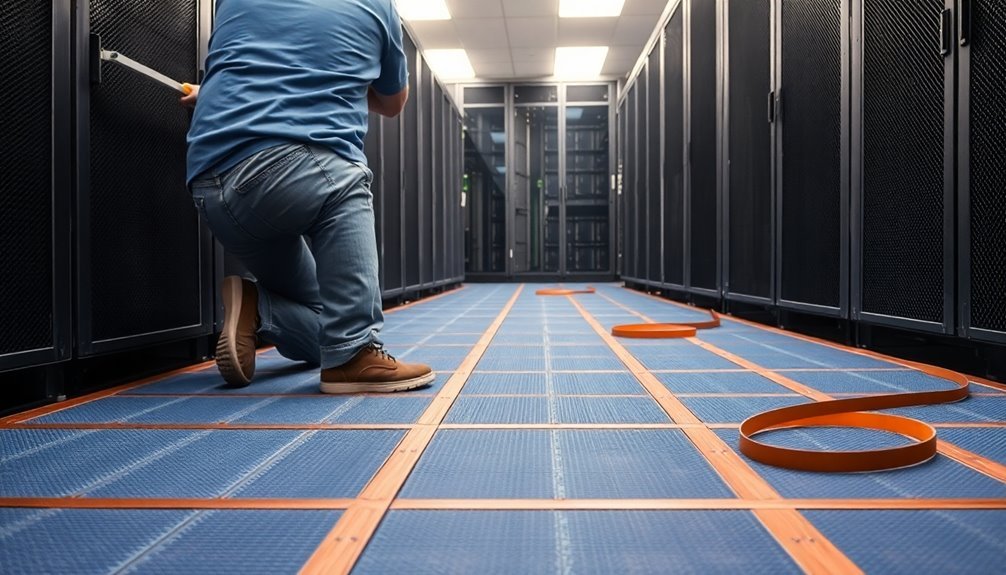
Every server room needs reliable ESD control flooring to prevent costly equipment damage from static discharge. When selecting your ESD flooring, make certain it maintains resistance below 1.0 x 10^9 ohms to ground and generates less than 100 volts of static charge, regardless of footwear type.
For safety, verify that the floor's resistance measures no less than 150 kilohms between any two points that are 1 meter apart. Hard-surface interlocking floors offer a durable installation option.
You'll need to test your flooring's performance using standardized methods like ANSI/ESD S7.1 for electrical conductivity and ANSI/ESD S97.2 for body voltage generation. Since server rooms don't typically control footwear requirements, choose flooring that inhibits static buildup regardless of shoe type.
The right ESD flooring will substantially reduce your need for humidification, leading to substantial energy savings.
During installation, establish proper grounding points based on your room's size and confirm compatibility with your raised floor structure. You'll need to maintain a clear conductive path to ground that won't degrade over time.
Regular maintenance and testing will help guarantee your floor's continued effectiveness in preventing static discharge and protecting your valuable equipment.
Maintain Optimal Humidity Levels
While ESD flooring provides a strong foundation for static control, maintaining proper humidity levels creates an additional layer of protection for your server equipment. You'll want to keep your server room's relative humidity between 40-60% to effectively minimize ESD risks while preventing condensation damage. According to ASHRAE guidelines, staying within a broader range of 20-80% is acceptable but requires closer monitoring.
Install temperature and humidity sensors throughout your server room for real-time monitoring. Set up automated alerts that trigger when humidity drops below 30% or exceeds 70%.
If your humidity levels are too low, you'll need to deploy humidifiers to prevent static buildup. Conversely, use dehumidifiers when moisture levels climb too high.
To maintain consistent humidity control, seal any cracks in your server room's walls, floors, and ceilings. This prevents unwanted moisture infiltration and helps your humidity control systems work more efficiently.
Monitor your room's dew point temperature to stay ahead of potential condensation issues, and optimize your air intake to minimize the introduction of humid air.
Don't forget to regularly maintain your humidity control equipment – proper upkeep guarantees your systems continue functioning effectively. Remember, stable humidity levels not only protect against ESD but also extend the life of your valuable server equipment.
Deploy Anti-Static Server Room Curtains
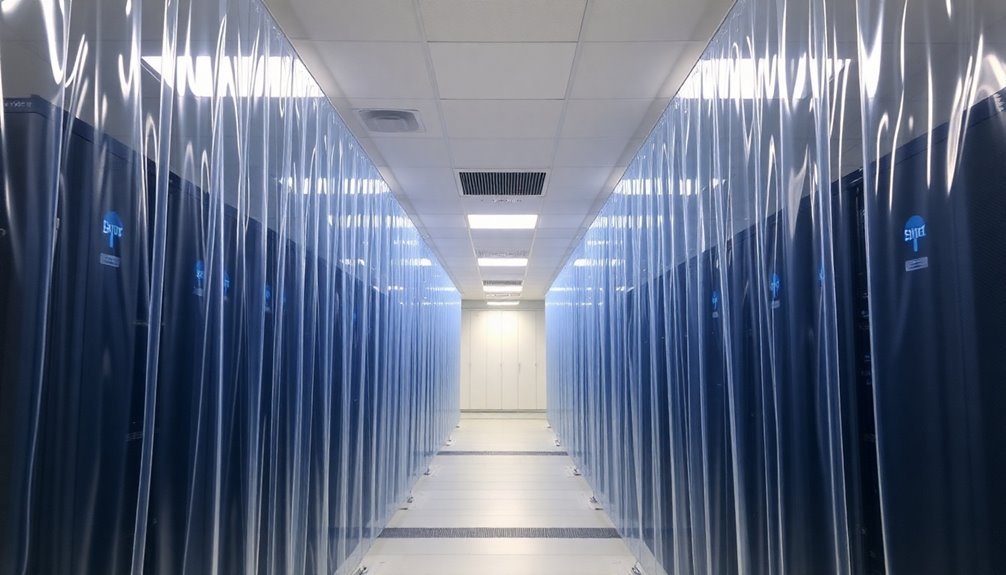
Installing anti-static server room curtains provides critical protection against electrostatic discharge while optimizing your facility's airflow management. You'll benefit from a 25% reduction in energy costs while maintaining proper separation of hot and cold air zones, protecting your sensitive equipment from static damage. The curtains' eco-friendly PVC material ensures sustainable operations without compromising performance.
When selecting anti-static curtains, choose PVC materials with 12-14 Mil thickness and make sure they include proper grounding components. You'll want to verify that your curtains come with necessary installation accessories like grommets, Velcro attachments, and appropriate mounting options.
| Feature | Benefit | Application |
|---|---|---|
| Anti-static PVC | Prevents ESD damage | Server rooms & cleanrooms |
| Fire-resistant material | Enhanced safety | High-risk areas |
| Grounding system | Static discharge control | Equipment protection |
Install your curtains using the provided mounting options, which include flatwall hookbeads, in-jamb mounts, or roller tracks. You'll find they're effective across temperatures from -15°F to 122°F, making them suitable for various environmental conditions. Remember to verify that your chosen curtains comply with ESD control standards and ASHRAE recommendations to guarantee ideal protection for your server room environment.
Implement Personnel Grounding Protocols
Beyond physical barriers like anti-static curtains, proper personnel grounding forms the backbone of effective ESD protection in server rooms. You'll need to implement thorough grounding protocols that connect both equipment and personnel to common ground points, preventing potentially damaging static charges from building up. Regular inspections with multimeters should be performed to verify grounding effectiveness.
Start by installing ESD flooring and requiring conductive footwear for anyone entering the server room. You'll also need to equip your staff with grounding wrist straps that connect directly to designated grounding points. Add dissipative work mats at each workstation to create ESD-protected areas where technicians can safely handle sensitive equipment.
Make sure you're following ANSI/TIA-942 standards and FIPS 94 guidelines for your grounding implementation. Install a Signal Reference Grid to bond all ground references to a common equipotential plane, and guarantee all conductive surfaces are properly grounded.
Don't forget to address painted components with paint-piercing hardware to maintain continuity.
Set up a formal static control program with written procedures, and conduct regular checks of your grounding systems. You'll want to verify that bonding remains effective and that all grounding conductors maintain low resistance to ground over time.
Monitor Environmental Conditions
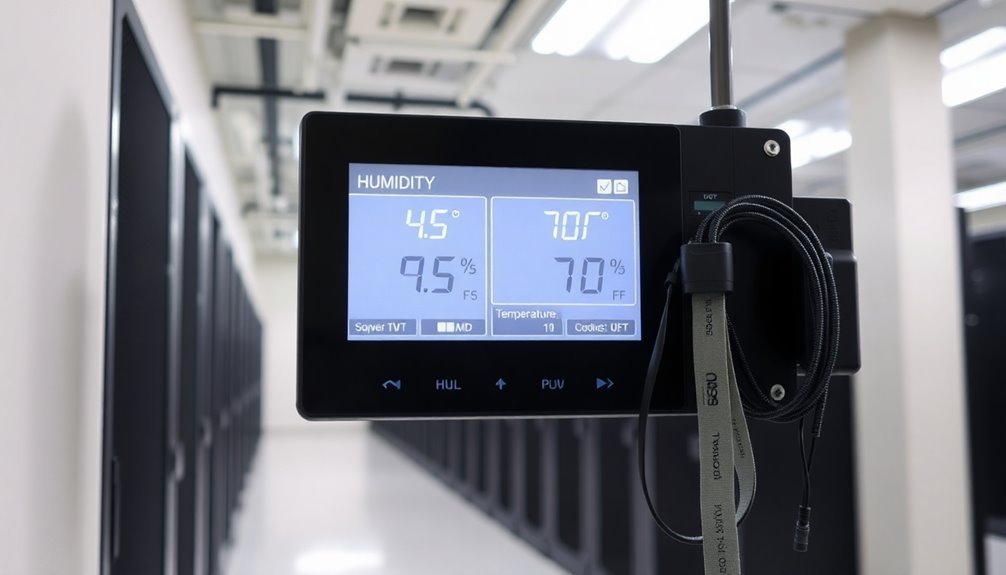
Maintaining precise environmental conditions is crucial for protecting server equipment from ESD damage. You'll need to keep your server room's temperature between 18°-27°C (64°-80°F) and maintain relative humidity levels between 40-60% to minimize static electricity risks. Regular monitoring helps prevent equipment downtime and complications like electrostatic discharge.
Install at least three temperature sensors per rack, focusing on inlet and exhaust points. Place sensors near air conditioning units and use rack-mounted options for accurate readings. Monitor the exhaust temperature to guarantee it doesn't exceed the inlet temperature by more than 20°C.
You'll want one humidity sensor for every five servers to track moisture levels effectively.
Implement a DCIM software solution to automate your environmental monitoring. This system will collect data, analyze trends, and send immediate alerts if conditions deviate from safe ranges. Use ASHRAE psychrometric charts and thermal maps to identify potential problem areas before they cause ESD issues.
Deploy wireless sensors throughout your server room and connect them to a cloud-based monitoring platform. Set up automated alerts via email or SMS when critical values are exceeded. You can access this data through any web browser or smartphone, making it easier to maintain ideal conditions that prevent static electricity buildup.
Establish Ionization Control Systems
You'll need to carefully monitor ion balance levels to prevent over-ionization or under-ionization that could harm your sensitive server equipment.
Position your ionizer units strategically throughout the server room, focusing on areas with the highest static risk and ensuring proper coverage of critical equipment zones. Keep humidity levels between 40-55% to complement ionization control and minimize static buildup.
Set up regular maintenance schedules to clean ionizer emitter points, verify ion output, and calibrate balance levels to maintain effective ESD protection.
Monitor Ion Balance Levels
An effective ionization control system stands at the forefront of ESD protection in server rooms. To maintain its effectiveness, you'll need to consistently monitor ion balance levels using specialized software like IRIS Client or IonManager Pro.
These tools provide real-time data on ionization performance and help you maintain the best protection for your sensitive equipment. Setting up decay time monitoring is crucial, with targets of 16 to 32 seconds for environments with good airflow.
You should set up your monitoring system to track ion balance continuously and establish alarm thresholds that'll notify you when levels drift outside acceptable ranges. Keep detailed calibration logs to track changes and identify patterns that might affect system performance.
When adjusting ionization levels, you'll want to find the ideal balance that maintains stable protection without interfering with server operations.
Make sure you're implementing regular performance measurements and adjusting the system based on the data you collect. Pay attention to cycle timing and ion sensing metrics to guarantee uninterrupted operation.
If you notice any imbalances, take immediate corrective action to prevent potential ESD events. Remember to document all adjustments and maintain these records for future reference and system optimization.
This proactive approach helps guarantee your server room maintains consistent ESD protection around the clock.
Strategic Ionizer Unit Placement
Once you've established proper ion balance monitoring, the next step is maximizing its effectiveness through strategic ionizer placement.
Start by analyzing your server room's layout and airflow patterns to identify the best locations for your ionization units. You'll need to map out areas containing ESD-sensitive equipment and determine whether ceiling-mounted or floor-standing ionizers will work best in your space.
Position your ionizers close to ESD-sensitive equipment and at air intake points to guarantee maximum protection. Maintaining consistent temperature levels throughout the server room is crucial for optimal ionizer performance. Make sure you're considering the coverage area of each unit and avoiding any obstructions that could interfere with ion distribution.
You'll want to integrate these units with your existing ESD control systems while maintaining enough clearance for proper operation.
Have professionals handle the installation to guarantee correct setup and calibration. They'll help you adjust ion output levels and balance controls to match your specific ESD protection requirements.
Don't forget to document all installation details, settings, and performance metrics for future reference. Schedule regular maintenance checks to verify your ionizers remain properly calibrated and effective.
Remember to follow industry standards and guidelines when placing ionizers in your ESD-protected areas.
Regular Maintenance Schedules
Regular maintenance schedules form the backbone of an effective ionization control system. You'll need to establish a thorough monitoring routine that includes real-time system status checks and fault detection through your facility's network.
Set up automated notifications via text or email to alert your maintenance team of any issues that require immediate attention.
Your maintenance protocol should include regular inspections of emitter points, sensors, and cables. You'll want to implement a systematic approach to component replacement, ensuring worn parts are swapped out before they fail.
Don't forget to check air flow patterns regularly, as proper air circulation is vital for effective ionization control.
Keep your system's software and firmware up to date to maintain peak performance. You should generate and review performance reports regularly, using the system's statistical tools to track trends and identify potential issues before they become problems.
Make sure your maintenance schedule aligns with ESD compliance standards, particularly ISO S20.20. When developing your maintenance plan, consider your server room's specific requirements, such as temperature control and leak detection protocols.
Integrate these checks into your routine to create a cost-effective maintenance strategy that protects your valuable equipment.
Create Equipment Handling Guidelines
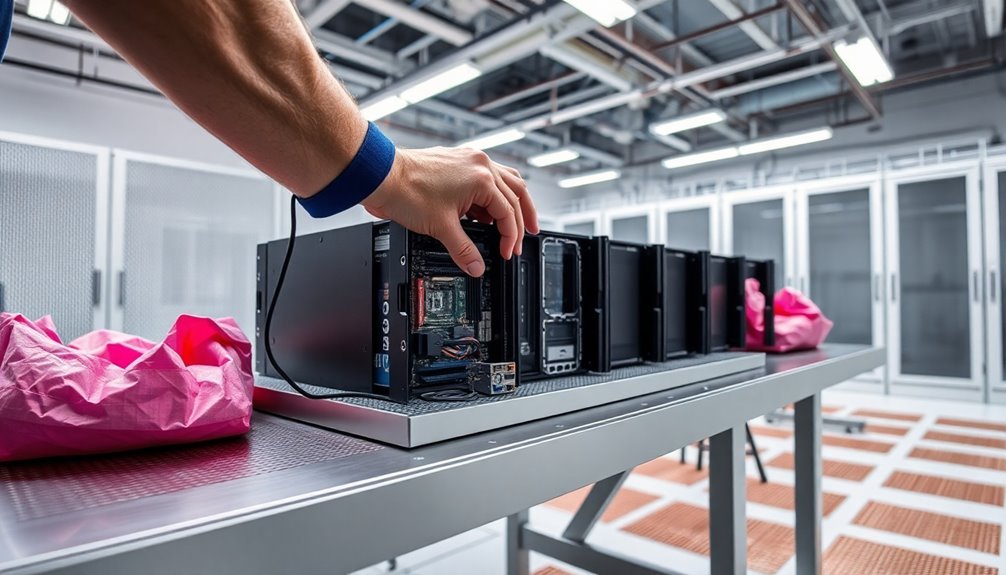
The successful operation of a server room depends heavily on proper equipment handling guidelines. You'll need to establish strict protocols for static control, implement proper physical placement strategies, and maintain environmental controls to protect your valuable equipment.
Start by creating designated EPAs where you'll handle sensitive equipment, and guarantee everyone uses proper grounding techniques including wrist straps. When installing equipment, you'll want to place heavier items at the bottom of racks and maintain proper spacing for efficient airflow. Don't forget to use blanking panels in empty rack spaces to direct air efficiently.
| Protection Area | Required Actions | Key Equipment |
|---|---|---|
| Static Control | Use wrist straps, maintain grounding | ESD mats, grounding points |
| Physical Handling | Space equipment properly, manage cables | Cable organizers, rack mounts |
| Environmental | Monitor temperature, control humidity | Sensors, dehumidifiers |
Remember to conduct regular inspections of your equipment and cables. You'll need to maintain proper documentation of all handling procedures and guarantee your team is well-trained in ESD prevention. Keep emergency communication systems readily available and maintain clear pathways around your equipment for safety and accessibility.
Frequently Asked Questions
How Often Should ESD Protection Equipment Be Tested and Recalibrated?
You should test wrist straps daily, check worksurfaces quarterly, verify ionizers quarterly, and inspect continuous monitoring systems semi-annually. Specific testing frequencies may vary based on your equipment sensitivity and environment.
Can Wireless Devices Affect the Effectiveness of ESD Protection Measures?
Yes, wireless devices can disrupt your ESD protection. They won't provide proper grounding and may interfere with monitoring equipment. You'll need traditional wired ESD solutions for reliable protection of sensitive electronics.
What Emergency Procedures Should Be Followed After a Major ESD Event?
You'll need to immediately evacuate personnel, assess damage, document the incident, and contact your emergency response team. Don't reset systems until you've completed safety checks and identified the root cause.
How Do Seasonal Changes Impact ESD Protection Requirements in Server Rooms?
You'll need stronger ESD protection in winter's low humidity and lighter measures in summer's high humidity. Always monitor your server room's conditions and adjust humidification systems to maintain ideal ESD protection year-round.
Are There Specific Cleaning Products That Can Compromise ESD Protection Systems?
Yes, you'll need to avoid Dettol, IPA wipes, regular anti-bacterial cleaners, waxes, and bleach-based products. These can damage your ESD protection by leaving residues or compromising the dissipative properties of surfaces.
In Summary
You'll save thousands in equipment damage by implementing these ESD protection measures in your server room. Don't wait for a static discharge incident to take action. Follow these seven tips religiously, train your staff properly, and regularly audit your ESD control systems. Remember, it's much cheaper to prevent static damage than to replace sensitive equipment or deal with system downtime.

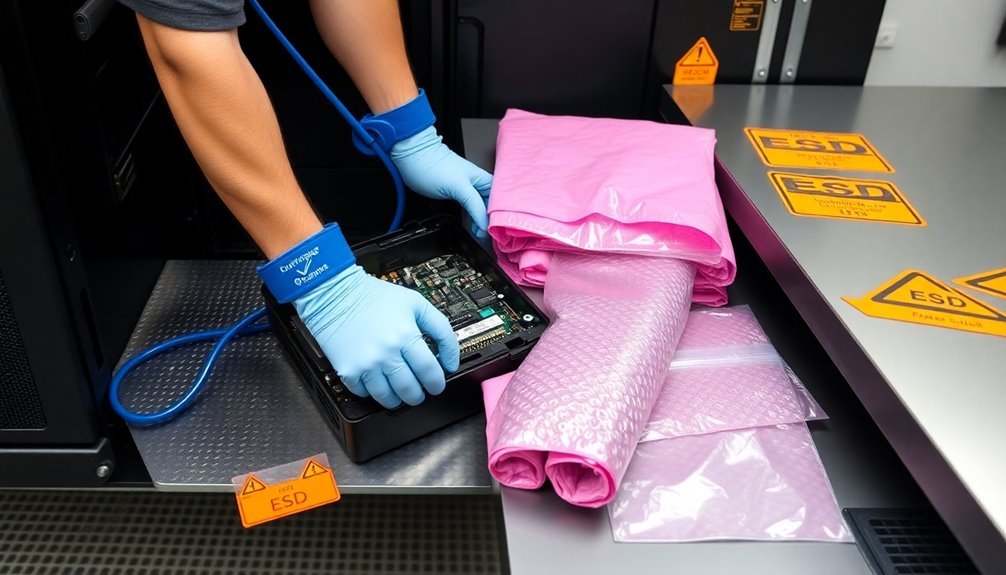



Leave a Reply